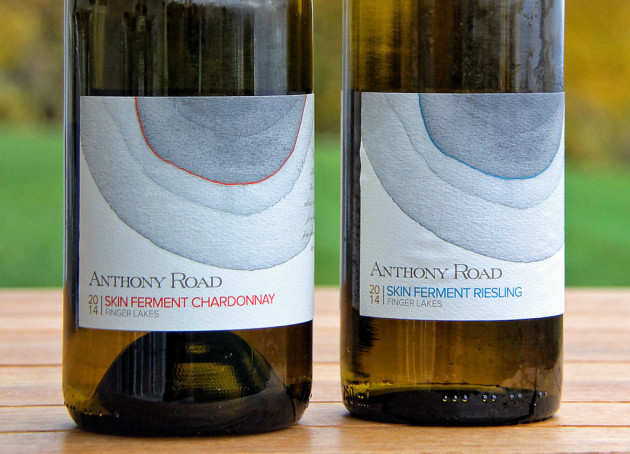Across the Finger Lakes, creative winemakers like August Deimel, Katey Larwood, Steve Shaw, Peter Becraft, Vinny Aliperti and others are employing traditional techniques with well-known grape varieties to produce innovative, new wines. Frequently referred to as “orange” or “amber,” these new wines are challenging establish perceptions of mainstay wines made from varieties such as chardonnay, gewurztraminer, vignoles and even riesling — the iconic grape of the region.
What the wines have in common is that they are white wines that utilize extended skin contact during maceration and subsequent fermentation. This approach represents a major deviation from winemaking practices commonly employed today. A fundamental tenant of modern winemaking is that while grape skins, seeds and other components of the pulp are essential for imparting flavor, structure and color to red wines, their use in the production of white wines should be avoided in order to eliminate any degradation of the fruit and other aromatic characteristics of the wine.
By allowing the wine to remain in contact with the skins, Finger Lakes winemakers are able to produce white wines that reveal a host of new aromas and flavors, and are much more “weighty” and structured making them ideal for paring with foods that they traditionally have not accompanied.
Ironically, the idea of utilizing extended skin contact when fermenting white wines is actually not new. Until the last millennia, wine was routinely fermented utilizing all of the components of the grape. Wine historians cite the Caucasus region of the country of Georgia as the origin for many classic winemaking techniques including the use of skins during fermentation. More recently, Italian winemaker Josko Gravner is credited with re-popularizing the technique through his “Natural Wine” movement. For Peter Becraft, head winemaker for Anthony Road Wine Company, producing skin ferment wines was a return to these traditional winemaking roots: “This style of winemaking is nothing new. By doing this, I’m not inventing anything. This is how wine was made for ages.” He added, “For me, it’s like going back into history to understand what the process did, and to understand why we have moved away from that.” For Becraft and Anthony Road, their path to rediscovering history began with the production of their first skin ferment wines with the 2013 vintage. Today, Anthony Road produces skin ferment wines from two white varieties, chardonnay and riesling.
For Vinny Aliperti, head winemaker at Atwater Vineyards and co-owner/winemaker at Billsboro Winery, the re-discovery of skin ferment wines evolved a more pragmatic question. “For me, it was more a function of trying to find a way to make the wine more interesting” explained Aliperti. “We were experimenting with how to re-invent chardonnay because it beckons to be re-invented. We were brainstorming ideas and skin fermentation came up.” While skin fermentation has been used at Atwater for nearly a decade, it was only recently that a skin ferment “orange” wine was produced. Aliperti described the evolution at Atwater further: “We would blend back the skin ferment wine into our final Chardonnay. It was usually ten to twelve percent of the total. But last year, George Nosis suggested that instead of using it for blending, we should take one of our best (skin ferment) barrels and bottle it up. So we did that as a special bottling for Atwater’s fifteen anniversary.”
Communicating and educating consumers on these new wines has proven to be a challenge for winemakers and wineries. While the adjectives “orange” and “amber” are often associated with the wines, the use of those terms often leads to confusion as to the nature of the wine as Aliperti pointed out: “the question we most often get asked by people who are not familiar with these wines is ‘are there oranges in this wine? We have to explain that there are actually no oranges or orange peels in it.” He added, “Amber is another term that is sometimes used, but there is no connotation of fruit. So amber is more the color. The term ‘skin fermented’ tells you all you need to know.” Anthony Road also prefers to describe their wines as “skin ferment” as Becraft explained: “We don’t advertise them as orange wines – they’re skin ferment and that’s the truth. It doesn’t matter what you call them. What matters is whether the wines are good.”
According to both winemakers, initial consumer reaction to the wines has been positive. When asked about the reaction commented: “Both wine geeks and non-geeks alike have been pleasantly surprised. The overall impression has been a positive one. It’s a whole other interpretation of what chardonnay is. They’re surprised at how complex it is and how this technique (skin ferment) brings out this diverse expression, this aromatic potpourri of flavors that you don’t get with a regular chardonnay.” Becraft echoed the positive reaction that he has seen: “The reaction has been positive, really positive. These wines are delicious wines to drink. They are wines that make you think. You think you know what the grape is, but you’re introduced to it in a whole new way. I like to say ‘you’re really looking at an old friend, but in a new way.”
It is far too early to tell whether skin ferment wines will continue to grow in popularity and gain acceptance as a legitimate expression of the varieties utilized, or whether they will fade into the winemaking history of the region as a passing fad. But if they do, someone may well rediscover them again in the future, and what was old will be new (yet) again.

